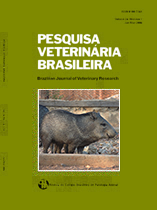 |
|
|
|
Year 2016 - Volume 36, Number 12
|

|
Viral type characterization and clinical aspects of canine parvovirus in naturally infected dogs in São Paulo State, Brazil, 36(12):1181-1185
|
ABSTRACT.- Monteiro K., Allendorf S.D., Vicente A.F., Appolinário C.M., Peres M.G., Cortez A., Heinemann M.B. & Megid J. 2016. Viral type characterization and clinical aspects of canine parvovirus in naturally infected dogs in São Paulo State, Brazil. Pesquisa Veterinária Brasileira 36(12):1181-1185. Faculdade de Medicina Veterinária e Zootecnia, Universidade Estadual Paulista Júlio de Mesquita Filho, Distrito de Rubião Júnior s/n, Botucatu, SP 18618-970, Brazil. E-mail: jane@fmvz.unesp.br
Since the first isolation of canine parvovirus type 2 (CPV-2) in late 70’s new virus types as CPV-2a and CPV-2b have been emerged and becoming prevalent in natural canine population and more recently, a third subtype was identified , CPV-2c. The main purpose of this study was to detect and characterize canine parvovirus currently present in Central-West region of São Paulo state, in Brazil. Fecal samples were collected of vaccinated and non-vaccinated dogs, clinically suspected of having CPV infection brought to the Infectious Diseases Service, Veterinary Hospital of FMVZ-UNESP. All samples (n=30) were screening for canine parvovirus through hemagglutination test and those resulting as positive (n=20) were submitted to PCR and the products were subsequently sequenced for subtype characterization. Results were tested for association with age, hematological values, viral hemagglutination titers in the feces, vaccination status and survival. Leukopenia was found in all animals, death occurred in 30% of unvaccinated dogs and in 42% of vaccinated ones. In a total of 20 positive sequenced samples, 18 were classified as CPV-2b, one as CPV-2c, and one as CPV-2a, being CPV2a and CPV2c detected in unvaccinated puppies. Compared to the reference samples amino acid change at position 426 in those circling virus was identified. The study results demonstrate the predominance of CPV-2b and the presence of CPV-2a and CPV-2c in naturally infected, vaccinated and unvaccinated dogs in in São Paulo region. |
| |
|
|
| |
|
 |